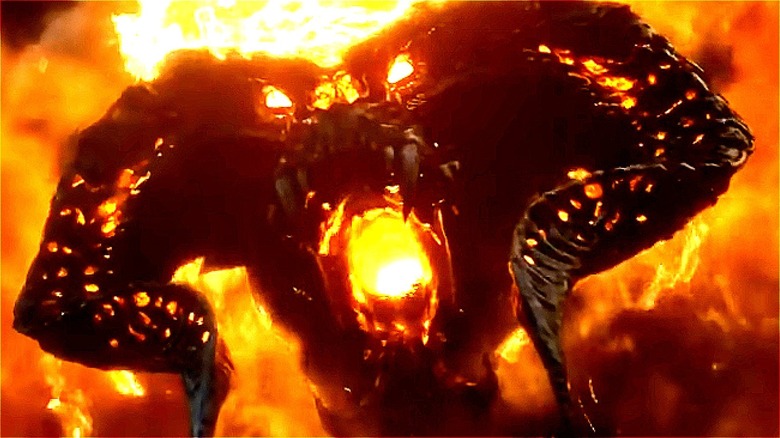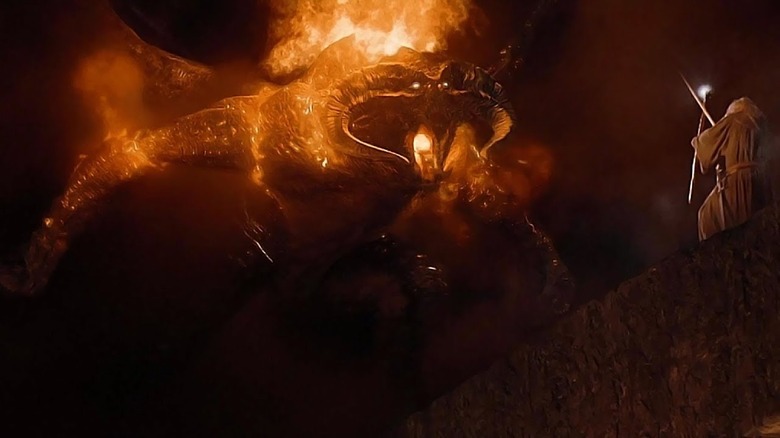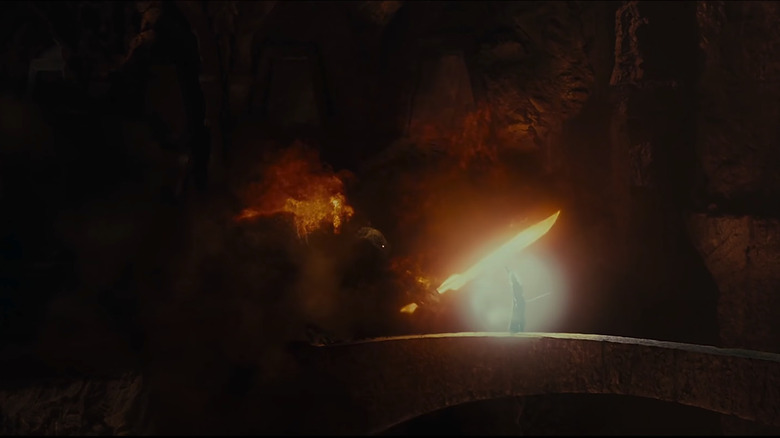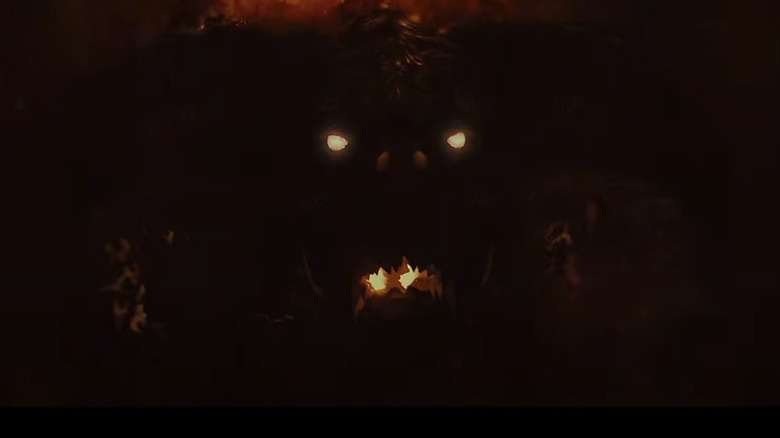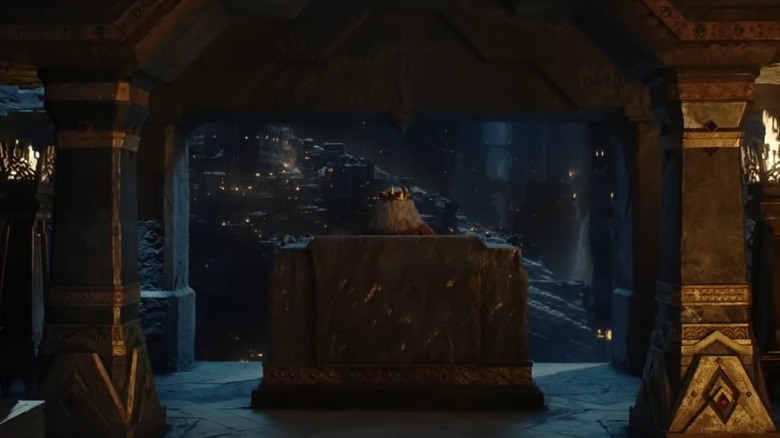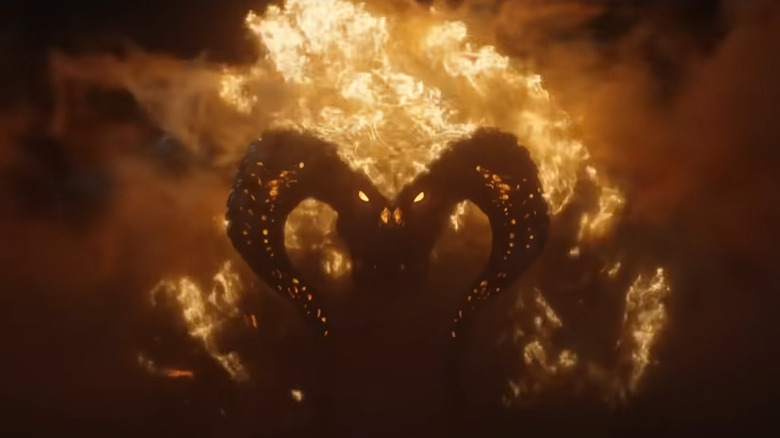How Is There A Balrog In Rings Of Power?
"The Lord of the Rings: The Rings of Power" is quickly approaching. As the show enters the final stretch before its September 2 premiere, the quantity of marketing material has exploded. In July alone, the show put out a short teaser, quickly followed by a full-length trailer packed with small details. All of this led up to the reveal of another full-length trailer at San Diego Comic-Con.
This flurry of activity has left fans of Middle-earth mulling over a lot of new footage. The Comic-Con trailer is particularly loaded with sinister elements, including creepy cult members, a mention of Sauron, and a Balrog. The fiery demon is saved for the last few moments: Its terrifying shape ignites in the inky blackness after the Amazon Prime banner fades away, leaving viewers with an eerie combination of horror and ecstasy at the return of such an infamous Tolkien villain.
While this shot of a Balrog is exciting, does it make sense? Is this the same demon we see fighting Gandalf on the Bridge of Khazad-dûm thousands of years later? It certainly has a Peter Jackson-esque feel, right down to the face-horns. Moreover, Balrogs are among the Middle-earth monsters that live indefinitely, so it certainly exists during the Second Age (when "The Lord of the Rings: The Rings of Power" is set). But what does the source material have to say about the prospect of a Balrog romping around during this era? We dug into the texts to find out. Here are a few theories regarding how a Balrog could feature in "The Lord of the Rings: The Rings of Power."
Balrogs are a pre-Rings of Power phenomenon
Technically, there are no Balrogs in the stories of Middle-earth's Second Age. They exist — or, at least one of them does — but they just aren't really doing anything. Where are they? Great question.
These fiery pain-in-the-necks have existed since the beginning of time. According to "The Silmarillion," the angelic beings known as the Maiar became followers of Sauron's original master, the first Dark Lord Morgoth. As the book puts it, "Dreadful among these spirits were the Valaraukar, the scourges of fire that in Middle-earth were called the Balrogs, demons of terror." The Balrogs feature heavily throughout the First Age of Middle-earth history, but when that age ends and the Second Age begins, they are destroyed or scattered in the shattering War of Wrath. In a letter written in 1954, Tolkien adds, "They were supposed to have been all destroyed in the overthrow of Thangorodrim, [Morgoth's] fortress in the North. But it is here found (there is usually a hang-over especially of evil from one age to another) that one had escaped and taken refuge under the mountains of Hithaeglin (the Misty Mountains)."
So, after the First Age, the only Balrog that remains alive and identified is the one hanging out under Moria. But even then, we don't see that guy until long after the story told in "The Lord of the Rings: The Rings of Power" plays out.
Durin's Bane in the Third Age
While Balrogs are busiest in the First Age and the era preceding it, they have a rather momentous footnote later in Middle-earth history too — and yes, we're referring to the troublemaker that shows up in "The Fellowship of the Ring." An appendix to "The Return of the King" describes the menace haunting Moria as a "terror that, flying from Thangorodrim, had lain hidden at the foundations of the earth since the coming of the Host of the West: a Balrog of Morgoth." The book also says this happens in the 1980th year of the Third Age.
At this point, the Balrog is roused by Dwarves who are famously delving too greedily and too deeply in search of precious mithril. When they wake the beast, they set a series of events in motion that leads to the destruction of their kingdom. This sets the stage for a deadly duel with Gandalf on a slender stone bridge a little over 1,000 years later.
What does all of this mean for "The Lord of the Rings: The Rings of Power"? Well, to summarize, the source material doesn't feature a Balrog at all between the end of the First Age and two-thirds of the way through the Third Age. That means we don't see a whiff of Balrog action in the source material Amazon Prime's series is based on. So why do we see a Balrog in the show's promotional footage? Apart from the fact that it's a sweet visual, we have a few different theories for how the demonic monster could factor into the show's story.
Settling down in a subterranean prison
The story of Durin's Bane (that's the Balrog in Moria) is one of fearful exile. The creature flees when its master falls, and eventually hides deep under a mountain for 5,000 years. We don't get a blow-by-blow account of how the monster comes to that spot — we simply hear that it flees there after Morgoth is destroyed.
This leaves an unspecified opening in the story during which the Balrog makes its way to its place of exile. Maybe the monster in the trailer is Durin's Bane, as it seeks a place of refuge deep under the mountains. Maybe it even causes some trouble along the way. After all, "The Silmarillion" says that during the beginning of the Second Age, men were grievously plagued by Morgoth's sinister monsters. It specifically references unnamed "demons" among these creatures, which could easily describe a Balrog.
If this is the case, the showrunners may have opted to weave the Balrog into their plans, not as an opposing force blocking the path of the good guys (as is the case in "The Lord of the Rings"), but as a creature running from them. It's even worth noting that a footnote in "The Return of the King" mentions that the phrase "roused from sleep," used to describe the Balrog's awakening, could also mean "released from prison." If the Balrog is trapped under the Misty Mountains until the Dwarves uncover it, maybe we'll witness the initial capture of the creature on the show.
Flashbacks and flash-forwards
Another option "The Lord of the Rings: The Rings of Power" might pursue is showing the Balrog in a flashback, or even a flash-forward. In terms of the former route, we know the Balrog flees to the Misty Mountains at the end of the First Age. This is a period that will likely be recapped during the show, since it's the immediate backdrop to the story. Maybe, as we hear about the War of Wrath, we'll see a quick shot of a Balrog as it worms its way into the mountains, Gollum-style.
This might not even be the same Balrog that we see in Moria in "The Lord of the Rings." If that's the case, we could just be seeing any old Balrog in a flashback summarizing how gruesomely terrifying the First Age was. If this is just a generic Balrog, it also stands to reason that it could be present during the show as a completely made-up part of the story.
Then again, the shot we see in the trailer could also be a prescient flash-forward. Perhaps someone in the show has a vision or a dream of the horrors to come. At one point in the trailer, the Dwarven king Durin III can be heard saying, "Beyond the darkness, tempting shadow, to bury us all beneath the mountain." This sounds prophetic, and like it's referring to a Balrog.
Compressing time
One of the biggest deviations from the books in "The Lord of the Rings: The Rings of Power" is the way it condenses Tolkien's original Second Age story into the lifespan of a single generation. While time will go by as the story progresses, it will do so at a much slower pace than the actual 3,500 years it takes for the Second Age to play out in the text.
This time compression shows that the creators are willing to make significant (albeit thoughtful) changes to the story. If that's the case, is it really too much to suggest that they also rope the "awakening of the Balrog" narrative into their Second Age tale? Sure, it's an event that happens 2,000 years after the "Rings of Power" story ends, but what's a little more time-finagling when you've already smooshed 3,500 years of events into a single point in time? However fans might feel about it, this does seem like it could be an option.
Regardless of whether the Balrog is a vision, a memory, or an active part of the story, there are certainly multiple ways it can be worked into the show without wandering too far from the source material. Then again, we might be seeing a full deviation from Tolkien's writings, which means the Balrog could factor into the story in a bigger and more time-compressed way. Maybe they've even gone so far as to make up a new Balrog that will specifically be a part of their show. However it plays out, the presence of this demonic terror in "The Lord of the Rings: The Rings of Power" is bound to spark excitement — and some fantastic visuals to boot.
